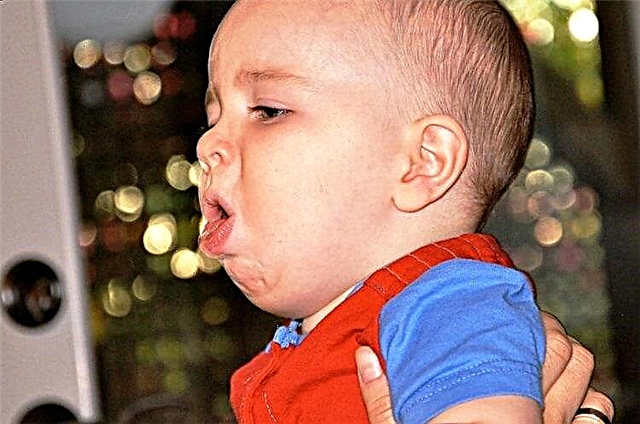You cannot find a person who could calmly watch a child cry. Before you find an effective way to calm your baby, you need to figure out what caused the roar.

Baby crying is a common cause for concern for parents
Why does the child often cry
Newborn babies often attract attention by crying, because they do not have the opportunity to express their needs differently. They can react in this way to pain, show fear, and communicate that they are hungry, unhappy, or want to sleep.
It is especially difficult to understand why a baby under one month of age cries. Here the baby is still adapting to a fundamentally new environment for him and can scream for almost any reason. Much depends on the temperament of the child: a hyperactive baby will accompany even the slightest discomfort with a loud roar, while a calm one, even if he has a tummy ache, will only groan and whimper.
Parents of babies in the first months of life are advised to observe the crumbs and the specifics of their behavior especially carefully. If you do everything correctly, after a couple of months it will not be difficult for them to recognize the reasons for crying according to a variety of parameters. Knowing why the hysteria started, it is much easier to find an effective way to quickly calm the newborn.
There is no single recipe for what you can do to keep your newborn from crying. Crying should not be ignored in any case. This approach can lead to psychological trauma - if the baby does not feel the attention and love from the parents, over time this will inevitably develop into a serious inferiority complex. The first thing that is required on the part of the parents when the child is crying a lot and is not going to calm down is to find out the reason for this behavior. There can be many of them.

The roar of children should never be ignored
The main reasons for crying
Some of the most common causes of crying in babies include:
Hunger
Any pediatrician will confirm that most often the baby cries from hunger. The fact is that the stomach of a newly born child is very small, which is why it needs to be fed often and little by little. So, having heard the hysterical children's crying, the first thing that mommy should do is offer the baby a breast.
Important! You can check if the baby is hungry without latching on to the breast. It is enough for the mother to bend her little finger and touch it to the corner of the child's mouth. If the baby turns its head towards the stimulus and opens its mouth, it means that it is hungry, and feeding should begin.
If hungry crying continues, despite regular and frequent meals, it is recommended to pay attention to the dynamics of weight gain in infants. It is possible that the baby has insufficient breastfeeding, and the time has come for the introduction of complementary foods.
Cold and heat
Children tolerate heat and cold much worse, because they have not yet fully formed the process of thermoregulation of the body. Too low or too high ambient temperature causes quite understandable discomfort in children, which they show through roaring.
Important! Reddened and hot skin of the baby indicates that he is hot. If your baby's skin is paler than usual and the tips of his fingers and toes are cold, he is frozen.
Overwork
Crying regularly before bed is a clear sign of overwork. Normally, crumbs under the age of three months should sleep from 18 to 20 hours. They quickly get tired both physically and psycho-emotionally. In both cases, crying and increased moodiness become a reaction to overwork.
Important! The more fatigued your baby is, the stronger and longer it will cry.
The most logical thing to do in a situation where a child is feeling overexcited is to put him to bed. The trouble is that at the stage of overwork, the baby is not able to immediately calm down and fall asleep. A warm bath or stay in the fresh air will be effective to speed up the process of falling asleep when overworked. If weather conditions permit, you can put your baby to sleep on the balcony.
Pain
If the child is crying in pain, it is useless to calm him down. It is necessary to make certain efforts to eliminate the pain syndrome. The first thing to do is to understand what exactly is bothering the baby. It can be colic, stomatitis, otitis media, the first signs of a cold, headache, teething and much more. If you cannot quickly figure out the causes of pain in a child on your own, you should show him to a pediatrician for a diagnosis.
Causes of pain
To understand how to calm and lull a newborn child who is naughty about pain, you need to determine what exactly caused it. The most common problems for babies are colic, ear diseases and skin rashes.

Pain is another common cause of crying in babies.
Colic
Colic in babies is not uncommon. They can arise for various reasons:
- due to improper grip of the chest;
- when overfeeding;
- with artificial feeding;
- in case of violation by the nursing mother of the recommended restrictive diet, etc.
You can relieve the baby from an attack of colic by means of massage, warm bath, laying on the tummy. If the above steps do not help to solve the problem, it is recommended to seek professional help.
Ear disease
Ear problems are often the cause of crying in young patients. The pain is usually acute in this case. It can be caused by the formation of a sulfur plug or a progressive inflammatory process in the hearing organs, which develops against the background of a viral infection or ARVI.
If there is a suspicion of ear disease (eg, otitis media), self-medication is not recommended in the most urgent manner. You should immediately call a doctor for a diagnosis and appropriate treatment.
Skin rash
A skin rash does not always cause pain in babies. But she can itch a lot, thereby making the baby cry. The etymology of skin diseases can be different. In some cases, a skin rash is not dangerous, in others it is a symptom of the development of an infectious, autoimmune or allergic process. It is unacceptable to ignore or treat a rash in an infant on your own. To find out the root cause, you need to show the baby to a dermatologist.
Calming a child
If a newborn's tears are not pathological, parents must find a way to calm the baby. The following techniques may be effective in different circumstances.

There are many ways to calm your baby.
Swaddling
Keeping the baby constantly tightly wrapped in diapers is not worth it. If he is crying and cannot calm down, swaddling can be quite effective. Being constrained in movement, the baby intuitively recalls the times when he was in the womb, and feels protected.
Wiggle
No less effective in terms of calming the crumbs will be a gentle, but rhythmic swaying. Motion sickness satisfies the child's need to be in close proximity to the mother and in bodily contact with her. It is very important for a baby to smell the mother's body. This distracts him from unpleasant sensations and calms him down.
Whisper
White noise, or whispering, is another effective way to calm down your child. Monotonous hissing sounds should be reproduced directly above the ear of the baby. This method seems dubious to many, but it works perfectly.
Laying on the side
Sometimes lying on its side helps to stop the baby's roar. This position is comfortable for the child, he feels protected. In addition, the position on its side will minimize the likelihood that the baby will choke or choke upon regurgitation.
Dummy or breast
Sucking is natural for a baby. This makes using a pacifier or breastfeeding an effective way to calm the baby. The kid is distracted from what bothered him and stops being capricious.
When to see a doctor
Not in all cases, a child's tears can be stopped with improvised means and simple techniques. If the cause of crying is a disease or pathology, it will not work to calm the baby. It is imperative to consult a doctor if the moods are accompanied by one or more of the following symptoms:
- increased body temperature;
- frequent regurgitation;
- continuous crying;
- the presence of redness on the skin;
- cough;
- snot;
- refusal to eat;
- loose stools or lack thereof.

A constantly crying child should be shown to the doctor even if there are no other symptoms.
The immunity of a small child is still quite weak. Crying is the only way a baby can tell the world about his troubles and worries. If the tears do not stop, and the reason for them cannot be found out, it is better to play it safe and consult a pediatrician.



